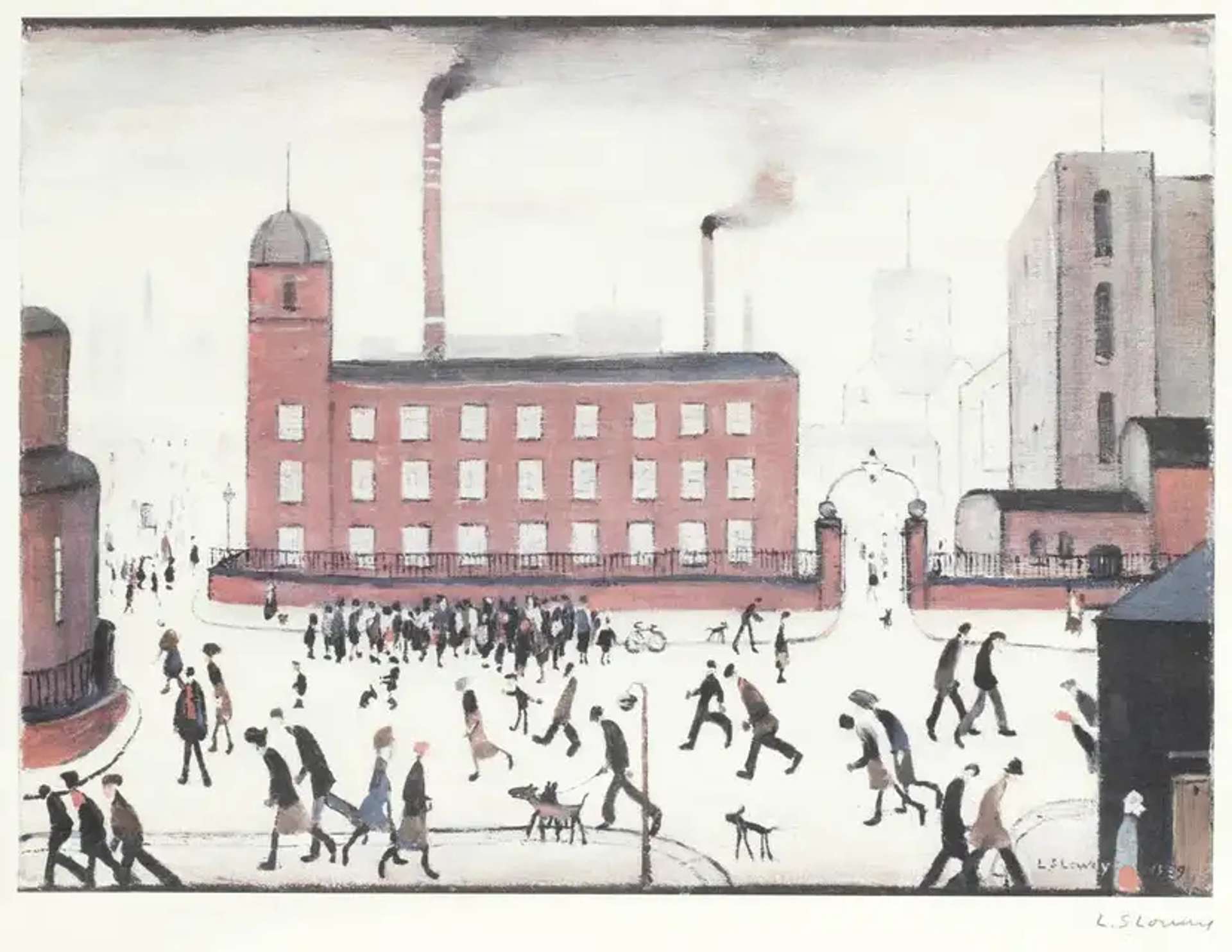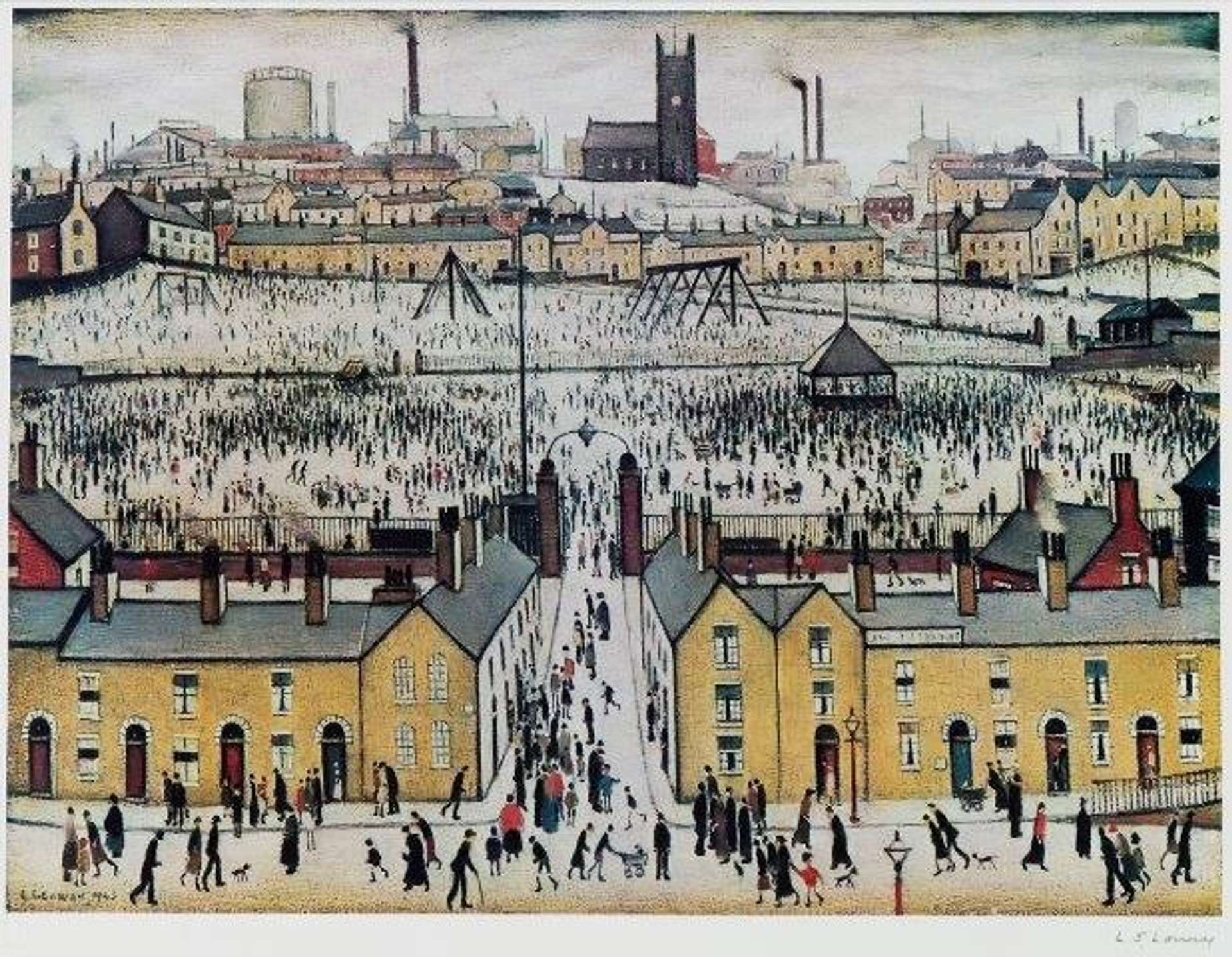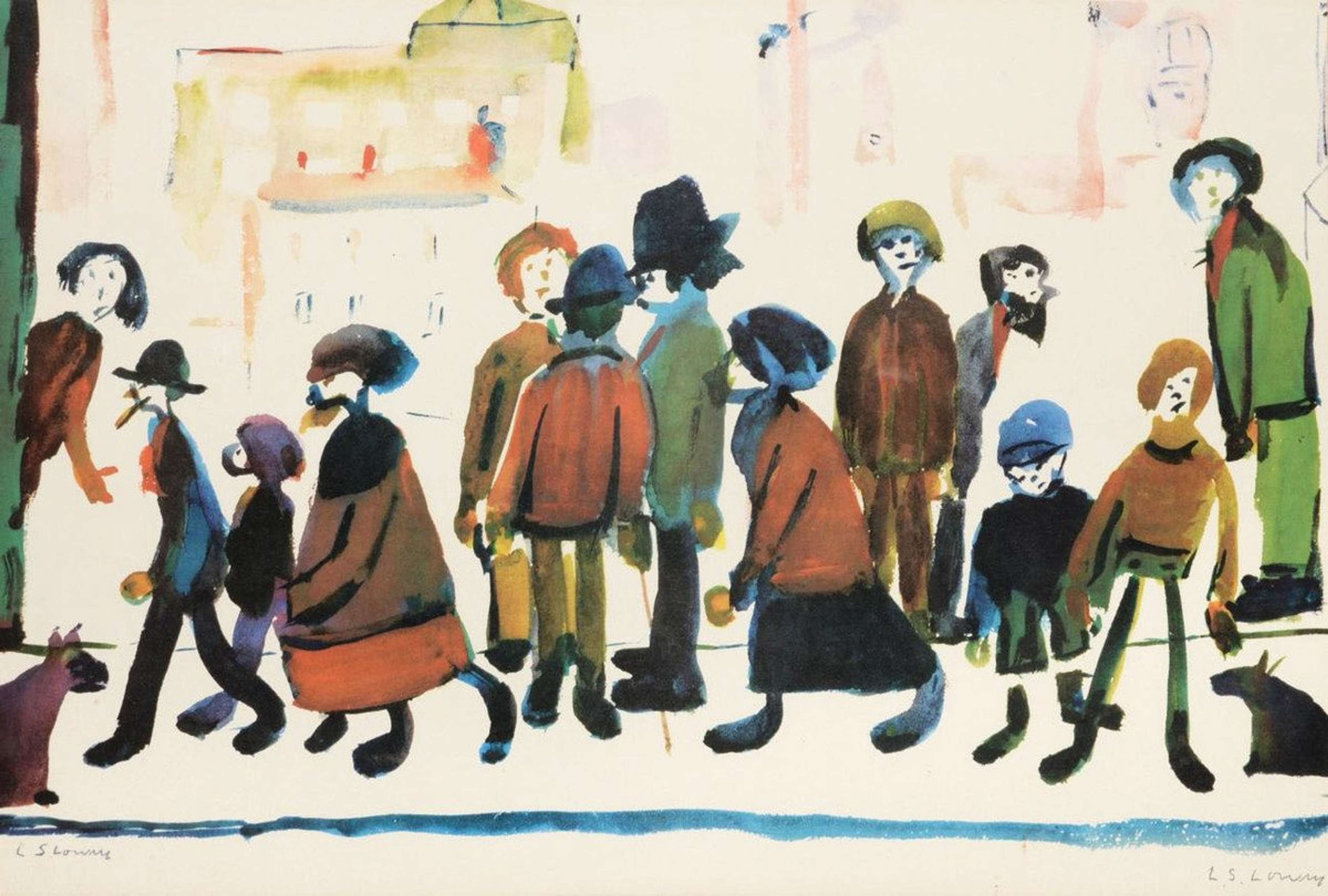 The Meeting Point © L.S. Lowry 1973
The Meeting Point © L.S. Lowry 1973
L S Lowry
73 works
A chartered accountant by day and a budding artist by night, L.S. Lowry’s journey from ledger lines to the lines of Manchester’s urban sprawl is nothing short of fascinating. His unique perspective, formed at the confluence of two contrasting worlds, gifted art enthusiasts with works that echoed both the daily grind of the working class and the shifting paradigms of industrial Britain.
From the simplistic elegance of his matchstick figures to the deep resonances of industrial landscapes, Lowry’s paintings offer a tapestry of tales – tales of resilience, transition, solitude, and community. Navigating Lowry’s legacy reveals more than his paintings; it offers insight into the narratives and influences behind his work.
A is for Apprentice
Laurence Stephen Lowry began his foray into the world of art not through formal education, but as an apprentice to a Manchester firm of chartered accountants. This phase of his life was juxtaposed with evening classes at the Manchester School of Art. It begs the question: how did this seemingly mundane daytime profession feed into the extraordinary urban landscapes and industrious scenes that would define his artistic legacy?
B is for Britain's Pre-eminent Genre Painter
While Lowry’s style was once considered naïve and rudimentary, he's now hailed as one of Britain's pre-eminent genre painter of the 20th century. This shift in perception speaks volumes about art's evolutionary appreciation. His industrial scenes, initially seen as bleak, later resonated with viewers, becoming emblematic of Britain’s post-industrial transition. The very fact that Lowry’s work remains ever-relevant prompts a reflection on the changing vistas of the urban British landscape.
C is for Coming From The Mill
One of Lowry's most acclaimed works, Coming From The Mill, encapsulates his signature style – depicting industrial landscapes populated by matchstick figures. This piece not only captures the hustle and bustle of early 20th century industrial Manchester but also symbolises the era's zeitgeist. In the swarm of minute figures, one witnesses the daily grind of countless individuals, revealing a deeper narrative of societal structures and human resilience.
D is for Depictions of Loneliness
Lowry’s artwork, while highlighting bustling urban scenes, often carried undertones of isolation and solitude. This duality presents a poignant reflection on the human condition within modern metropolises. Was it the changing landscape of industrial Manchester, or perhaps personal tribulations, that influenced such themes? The countless, seemingly insignificant figures amidst vast urban expanses echo the sentiment of individual insignificance in the face of overarching societal constructs.
E is for Everyman
Lowry’s scenes frequently feature matchstick men, representative of the everyman of industrial England. These small, simplified figures amidst urban landscapes evoke both the community spirit and anonymity of city life. Lowry’s portrayal not only captures the rhythm of urban routine but also subtly comments on the human condition in industrial settings.
F is for Factories
Factories, with their looming chimneys emitting plumes of smoke, are a quintessential element in Lowry's oeuvre. These industrial landmarks, so defining of Northern England's skyline during the 20th century, became a symbol of the era's mechanical progress and societal challenges. Through his brushstrokes, Lowry paints a narrative that intertwines daily labour with the broader industrial transformation taking place.
G is for Going To The Match
One of Lowry's most celebrated works, Going To The Match, depicts crowds heading to a football game. This piece, which was auctioned for a record price in 1999, captures the essence of community spirit and shared experiences. The intricate detailing and emotive ambiance in the painting serve as a timeless tribute to the joys of collective enthusiasm, a reminder of simpler times where community gatherings were the heart of social life. In 2022 Going To The Match (1954) sold for £7,846,500 (with fees), setting a record price for this original.
H is for Hometown
Lowry's deep connection to his hometown, Pendlebury in Lancashire, where he lived for over 40 years, is palpable in his works. This environment, with its industrial landscapes and bustling streets, shaped his artistic vision. His canvases resonate with the rhythms and tones of Pendlebury, immortalising its spirit and highlighting the relationship between an artist and his muse—the very place he called home.
I is for Industrial Landscapes
L. S. Lowry masterfully brings to life the industrial terrains of northern England through his iconic paintings. Depicting the rhythms of the working-class existence, his canvases are filled with towering smokestacks, bustling mills, and lines of terraced homes. Lowry's distinct approach, marked by his signature matchstick figures, provides a window into a time of swift industrial transformation. Yet, embedded within his artistry lies a deeper reflection: the potential sacrifices of humanity amidst relentless progress.
J is for Joy in Simplicity
At first glance, Lowry's figures convey simplicity. Yet, they pulse with life, emotion, and a distinct narrative. This celebration of ordinary people and everyday scenes shines through his work. But what's most compelling is his ability to speak to the depth in simplicity. It's a testament to Lowry's genius that he could uncover profound joy and beauty in the most unassuming moments of daily life.
K is for King Street, Manchester
One of Lowry's standout pieces, Piccadilly Circus, London, showcases his ability to depict urban life vividly. Yet, his frequent visits to King Street in Manchester influenced many of his works, blending local settings with universal themes of humanity and industry. The bustling crowds, dynamic street scenes, and intricate details make it more than a geographical location; it becomes a lens through which we see a bygone era.
L is for Legacy
Lowry's impact on art history is undeniably significant, and his legacy is cemented not only through his unique style but also through the L. S. Lowry Collection at Salford. This institution houses the world's largest public collection of his paintings and drawings. As artists continually evolve, where does Lowry fit in contemporary dialogues? His celebration of the industrial and ordinary challenges today's artists to find beauty in unexpected places.
M is for Millions
Lowry's industrial landscapes, though iconic, might not necessarily be his priciest works at auction. In 2011, The Football Match fetched a jaw-dropping £5.6m at a Christie’s auction in London, setting a record for Lowry's pieces. Reflecting on his increasing prominence in the art market, the average value of his art has surged by 16% in the past five years, now commonly reaching figures around £3,645. Lowry’s legacy continues to flourish, evident in the escalating demand for his creations in secondary markets.
N is for National Portrait Gallery
L. S. Lowry's contribution to the art world didn't go unnoticed by the esteemed National Portrait Gallery in the UK. While he's primarily known for his industrial scenes, Lowry was also an accomplished portraitist. One may ponder, how does the gallery's inclusion of his work reshape our perception of him? Displayed alongside titans of portraiture, his distinct style remains unmistakable, underscoring his ability to capture humanity, both in sprawling city scenes and intimate visages.
O is for Observation
Lowry's keen eye for the subtleties of daily life distinguished him from others. His scenes go beyond simple portrayals of industrial Manchester; they examine the lives of its people. From playful children to weary workers, Lowry’s art underscores the impact of observation
P is for Mrs Swindell's Picture
In 1967, L. S. Lowry painted Mrs Swindell’s Picture, depicting the route Bettie Swindell took daily to his house. Swindell, initially Lowry's cleaner, evolved into a close friend and confidante over 22 years. A unique detail is a cat, included at her granddaughter's request. The painting, having undergone multiple changes by Lowry, symbolises their warm relationship. Interestingly, the artwork has been auctioned five times in the past year, going for its highest price of £4,558 in August 2023.
Q is for Quayside
L. S. Lowry’s deep connection to urban landscapes often led him to depict scenes from the quaysides. The shipyards and docks of places like Manchester had a profound effect on his work. But what of the quayside truly captured Lowry's attention? Was it the industrial background or the bustling humanity? Historians suggest it's a mix of both, citing Lowry's ability to bring together both man and environment in a harmonious, though often melancholic, manner.
R is for Returning from Work
Painted in 1929, Lowry’s Returning From Work examines the lives of industrial workers in the UK. What's fascinating is how Lowry captures both the exhaustion and the tireless spirit of these individuals against a backdrop of factories. Does this piece ask us to consider the nature of industrialization and its human cost? The monochromatic hues and methodical brushwork certainly prompt such reflections.
S is for Street Scenes
Street scenes were a dominant theme in Lowry's work, reflecting the day-to-day life of working-class England. His paintings told tales of the ordinary person. Within them, one can almost sense the chatter, footsteps, and the city's distant hum. Lowry's portrayal of streets has set a benchmark, and his capture of the timeless essence of communal living continues to inspire contemporary urban artists.
T is for Tate
The Tate Gallery has been instrumental in cementing Lowry's place among the greats of British art. In 2013, The Tate Britain held a major exhibition dedicated solely to Lowry, showcasing over 90 works. This not only rekindled interest in his legacy but also posed questions about the ever-evolving relationship between modernism and tradition.
U is for Urban Landscapes
Lowry's fascination with urban life shines through in many of his paintings. His portrayal of industrial settings in England, especially around Manchester, offers a vivid glimpse into a bygone era. These urban landscapes, dotted with factories, mills, and terraced houses, often set against smoky skies, narrate the lives of the working class. Lowry's vision undoubtedly would have evolved to capture the nuances of today's cityscapes, reflecting modern times just as poignantly.
V is for Vision of Humanity
Lowry's matchstick men stand out as more than simple figures in his compositions. They embody the heart and soul of the English working class during the industrial era. These figures not only represent but also illuminate the struggles, aspirations, and ordinary moments of daily life. As art has evolved to mirror changing times, just as Lowry's vision epitomised the industrial age, today's art reflects our contemporary understanding and representation of humanity.
W is for Woman With A Beard
One of Lowry's more peculiar and intriguing works, Woman With A Beard captures attention with its unique subject matter. Far from his more known urban landscapes, this painting suggests Lowry's range and his fascination with the unusual. While it raises questions about gender, identity, and societal norms, it also poses a query about the artist's personal encounters. How does this piece contrast with today's more open conversations about gender fluidity?
X is for X-ray Revelations
In preparation for a Salford exhibition, curators x-rayed 12 L.S. Lowry works, unearthing the artist's guarded techniques. Lowry's use of dense white lead paint from the 1920s posed challenges, perhaps a deliberate move to veil his secrets. His thickly layered canvases, weighing significantly more than average, hinted at his meticulousness. Previous x-rays have unveiled concealed images beneath primary artworks, like accentuating Lowry's intricate, enigmatic approach.
Y is for Yacht
In his youth, guided by the Impressionist Adolphe Valette, Lowry painted Sailing Boats, melding Impressionist techniques with Northern England's moody skies. This early piece, unique in its realism, captures the powerful and sometimes dreadful allure of the sea for Lowry: a vast, unpredictable expanse that dwarfed human existence. This maritime piece, juxtaposed against his urban landscapes, highlights the contrasting force of nature and its looming vastness. Notably, this artwork stands alone as the only one his mother ever lauded.
Z is for Zealous Commitment
Lowry's zealous dedication to his craft and subjects is evident in his paintings. He wasn’t just a passive observer; he immersed himself deeply, often walking for miles around Salford and Manchester to observe and absorb the life around him. This zeal translated onto his canvases, where each work resonates with intricate details and emotions, making him an enduring figure in the world of art.















